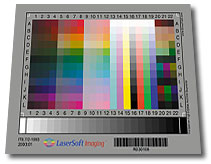Color chart
Color chart refers to a visual tool used to illustrate and communicate color choices and relationships. Color charts are widely used in various fields such as art, design, photography, printing, and manufacturing to ensure accurate color reproduction and to facilitate the understanding of colors.
History[edit | edit source]
The concept of the color chart has evolved significantly over time, with early examples dating back to the 18th century. One of the pioneers in the development of color systems was Isaac Newton, who introduced the color wheel in his book Opticks in 1704. This laid the groundwork for later color theories and charts. In the 19th century, scientists and artists like Johann Wolfgang von Goethe and Michel Eugène Chevreul made further contributions to the understanding of color theory and harmony, influencing the creation of more complex color charts.
Types of Color Charts[edit | edit source]
There are several types of color charts, each serving different purposes:
Pantone[edit | edit source]
The Pantone color chart is widely used in the printing and design industry to ensure the consistency of colors. It includes a large number of color swatches with specific Pantone numbers for easy identification and replication.
CMYK[edit | edit source]
The CMYK color chart is used in color printing and refers to the four inks used in some color printing processes: Cyan, Magenta, Yellow, and Key (black). This chart helps in selecting and specifying printing colors by mixing these four inks in various proportions.
RGB[edit | edit source]
The RGB color chart is used for digital displays, including computer monitors and televisions. It represents colors through combinations of Red, Green, and Blue light. This chart is crucial for web designers and digital artists to ensure accurate color representation on digital platforms.
RAL[edit | edit source]
The RAL color chart is a European color matching system used in architecture, construction, and industry to define standard colors for paint and coatings.
Importance[edit | edit source]
Color charts are essential tools for ensuring color consistency and accuracy across different mediums. They help in the precise communication of color, which is critical in branding, product development, and design. Without color charts, it would be challenging to replicate colors accurately, leading to inconsistencies and miscommunication.
See Also[edit | edit source]
Search WikiMD
Ad.Tired of being Overweight? Try W8MD's physician weight loss program.
Semaglutide (Ozempic / Wegovy and Tirzepatide (Mounjaro / Zepbound) available.
Advertise on WikiMD
|
WikiMD's Wellness Encyclopedia |
| Let Food Be Thy Medicine Medicine Thy Food - Hippocrates |
Translate this page: - East Asian
中文,
日本,
한국어,
South Asian
हिन्दी,
தமிழ்,
తెలుగు,
Urdu,
ಕನ್ನಡ,
Southeast Asian
Indonesian,
Vietnamese,
Thai,
မြန်မာဘာသာ,
বাংলা
European
español,
Deutsch,
français,
Greek,
português do Brasil,
polski,
română,
русский,
Nederlands,
norsk,
svenska,
suomi,
Italian
Middle Eastern & African
عربى,
Turkish,
Persian,
Hebrew,
Afrikaans,
isiZulu,
Kiswahili,
Other
Bulgarian,
Hungarian,
Czech,
Swedish,
മലയാളം,
मराठी,
ਪੰਜਾਬੀ,
ગુજરાતી,
Portuguese,
Ukrainian
Medical Disclaimer: WikiMD is not a substitute for professional medical advice. The information on WikiMD is provided as an information resource only, may be incorrect, outdated or misleading, and is not to be used or relied on for any diagnostic or treatment purposes. Please consult your health care provider before making any healthcare decisions or for guidance about a specific medical condition. WikiMD expressly disclaims responsibility, and shall have no liability, for any damages, loss, injury, or liability whatsoever suffered as a result of your reliance on the information contained in this site. By visiting this site you agree to the foregoing terms and conditions, which may from time to time be changed or supplemented by WikiMD. If you do not agree to the foregoing terms and conditions, you should not enter or use this site. See full disclaimer.
Credits:Most images are courtesy of Wikimedia commons, and templates, categories Wikipedia, licensed under CC BY SA or similar.
Contributors: Prab R. Tumpati, MD





